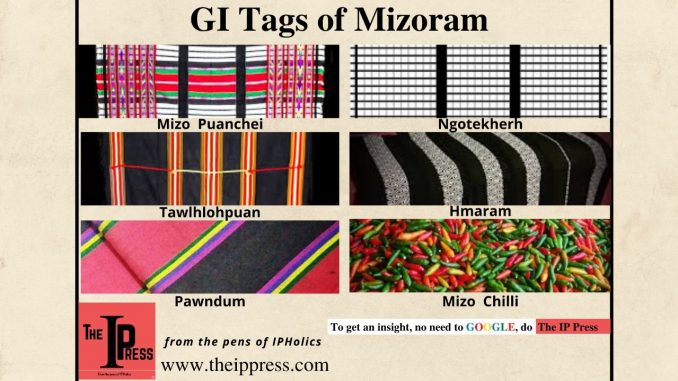
Geographical Indication Law [Geographical Indications of Goods (Registration and Protection) Act, 1999] protects the traditional culture and benefits the artisans, weavers, craftsmen socially as well as economically. The Law protects all kind of products including, natural, manufactured, handicrafts, horticulture, agriculture and so on. Interestingly, Mizoram one of the Indian States is popularly known for its good quality diverse traditional fabric, weaving and intricate designs handicraft.
To inform you about the diverse fabric, the blog lists below the GI Tags of Mizoram. All these tags were secured in August 2019 and the application for all the enumerated handicrafts was filled by Mizoram Art & Cultural Society.
- PAWNDUM
An essential traditional cloth of the Mizo community, Pawndum, is produced throughout the state of Mizoram, but the main centre of production is at Aizawl and the village of Thenzawl. As the name suggests, Pawndum means ‘black cloth’, though not entirely black, it is striped with red colour. Pawndum is worn by wrapping it around the waist and covers the lower part of the body down almost to the feet. In earlier times, young men used this puan as a night cover during their stay in the men’s dormitory (Zawlbuk) and was also used as attire while performing ‘Khuallam’, one of the famous traditional dances of the Mizos. Traditionally a young Mizo woman was required to weave a Pawndum and carry it along to her new home when she got married. Pawndum has a deep cultural significance, even to this day. It assumes different names according to the purpose. Thus, when it is used to cover the dead body, it is known by the name ‘Thihrin puan’ expressing condolence and tragedy. While it takes the name ‘Zawlpuan’ if it is presented as a token of affection and love or to establish a cordial relationship with someone. [For more details click here].
- NGOTEKHERH
Ngotekherh is an ancient culturally significant puan worn by the Mizo community. In the beginning, this puan was popularly known as Puanhruih and it appears to have received this name from the word Hruih which in Mizo language means transverse stripes on cloth. Delicately sewn on a loin loom, this puan has a plain white base with two narrow black stripes also known as “kherh” running along its edge. These stripes are sewn vertically along the length of the puan which makes it appear as if it divides the shawl into two parts. However, to keep pace with the fashion trends, the Ngotekherh has undergone several changes and improvements. [For more details click here].
- HMARAM
An elaborately decorated textile of the Mizo tribe and is also one of the most popular textiles a Mizo woman is associated with. The design is unique and has a deep root in society. It is a small skirt, only worn by ladies and girls. The cloth is wrapped around the waist by tucking in at the waist to fasten it, covering the lower part of the body. It is commonly worn during festive dances and official ceremonies. Also, regarded as the oldest patterned textile of the Lusei tribe, Hmaram is generally worn during festive dances and official ceremonies. The motifs and patterns in Hmaram were derived from the flora of the geographical area of Mizoram, such as the Kawkpuizikzial motif inspired by the curled new shoot of an edible fern Kawkpui (Cyathea chinensis), Lenbuangthuam motif derived from Lenbuang tree i.e. Griffith’s Plum Yew (Cephalotaxus griffithii), Disûl motif (Di is a plant under grass family), etc. [For more details click here].
- TAWLHLOHPUAN
One of the essential Puan shawls in the textile heritage of Mizoram, Tawlhlohpuan, means “to stand firm” or “not to move backwards”. It was worn by courageous warriors among the Mizo men as a symbol for their bravery. Before going out to fight in a war, Tawlhlohpuan was draped on the warriors in the Kawrtawnghak style of draping. In one Mizo folktale, a great warrior (Pasaltha in Mizo) named Darhnawka of Hualngo clan requested his wife to weave him a special cloth that was big enough to wrap his body if he died during a hunt or war. When Darhnawka wore the cloth, it meant that he was prepared to lay down his life and never retreat. The highest award offered for bravery/chivalry in the Mizo society is the draping of the Tawlhlohpuan. Therefore, Tawlhlohpuan holds high significance in the Mizo society and thus it cannot be possessed by all household of the society. It is produced throughout the state of Mizoram, and the main centre of production is at Aizawl and Thenzawl town. [For more details click here]
- MIZO PUANCHEI
Mizo Puanchei is the most colourful and popular among the Mizo Puan (Shawl/textile) and it is an essential possession for every Mizo lady. It is wrapped around the waist by tucking in at the waist to fasten it, covering the lower part of the body. It is an important item in their marriage outfit, and the most commonly used costume in their festive dances and official ceremonies. Puan is the name given by the Mizo to the cloth or the fabric which is woven out of the loom. The traditional loom use by the Mizo is the loin-loom. Generally, two pieces of cloth are woven which are delicately sewn together to form one complete Puan. [For more details click here].
Mizoram possess the following GI Tags-
- Mizo Chilli (Agricultural) here
- Pawndum (Handicraft) here
- Ngotekherh (Handicraft) here
- Hmaram (Handicraft) here
- Tawlhlohpuan (Handicraft) here
- Mizo Puanchei (Handicraft) here

Leave a Reply